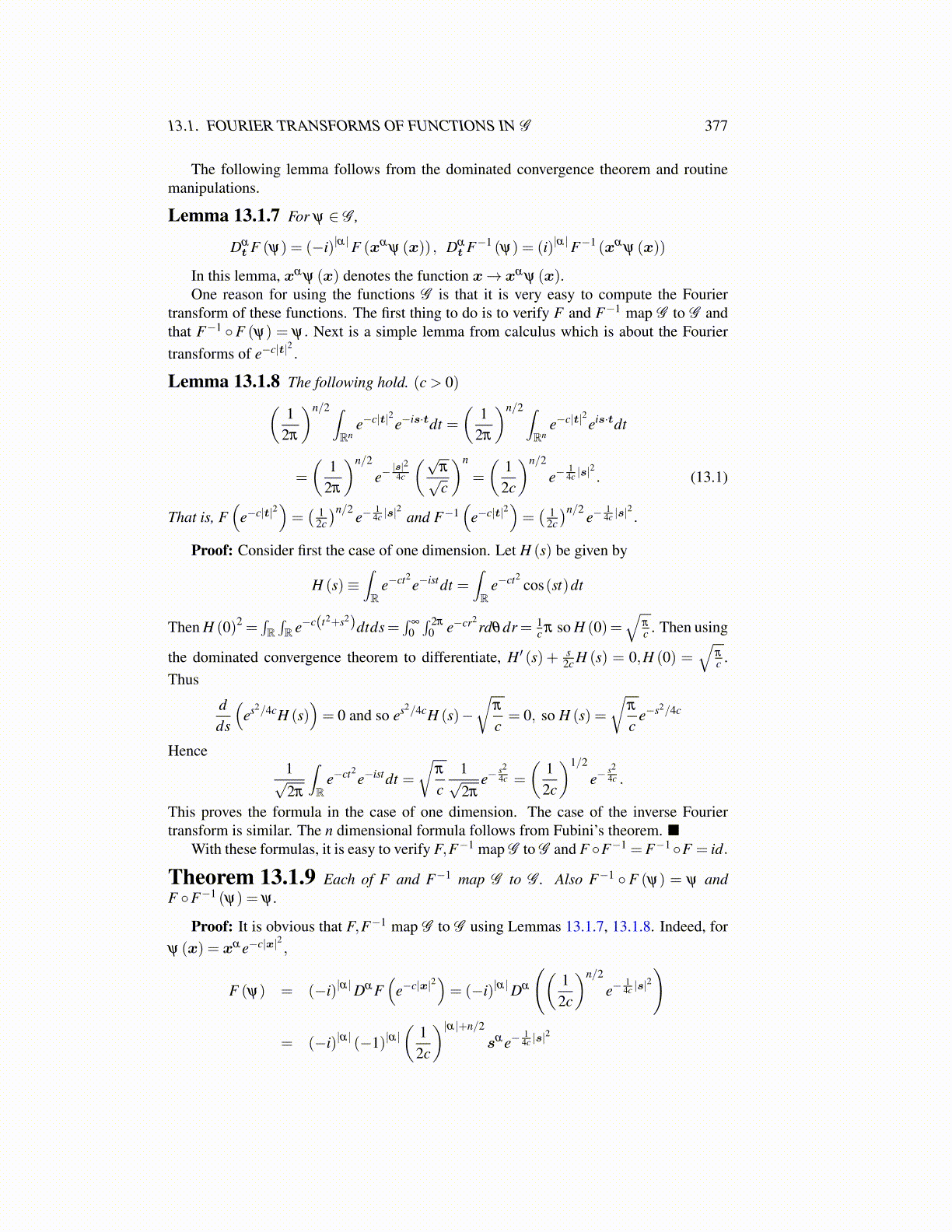
13.1. FOURIER TRANSFORMS OF FUNCTIONS IN G 377
The following lemma follows from the dominated convergence theorem and routinemanipulations.
Lemma 13.1.7 For ψ ∈ G ,
Dαt F (ψ) = (−i)|α|F (xα
ψ (x)) , Dαt F−1 (ψ) = (i)|α|F−1 (xα
ψ (x))
In this lemma, xα ψ (x) denotes the function x→ xα ψ (x).One reason for using the functions G is that it is very easy to compute the Fourier
transform of these functions. The first thing to do is to verify F and F−1 map G to G andthat F−1 ◦F (ψ) = ψ. Next is a simple lemma from calculus which is about the Fouriertransforms of e−c|t|2 .
Lemma 13.1.8 The following hold. (c > 0)(1
2π
)n/2 ∫Rn
e−c|t|2e−is·tdt =(
12π
)n/2 ∫Rn
e−c|t|2eis·tdt
=
(1
2π
)n/2
e−|s|24c
(√π√c
)n
=
(12c
)n/2
e−14c |s|
2. (13.1)
That is, F(
e−c|t|2)=( 1
2c
)n/2e−
14c |s|
2and F−1
(e−c|t|2
)=( 1
2c
)n/2e−
14c |s|
2.
Proof: Consider first the case of one dimension. Let H (s) be given by
H (s)≡∫R
e−ct2e−istdt =
∫R
e−ct2cos(st)dt
Then H (0)2 =∫R∫R e−c(t2+s2)dtds=
∫∞
0∫ 2π
0 e−cr2rdθdr = 1
c π so H (0)=√
π
c . Then using
the dominated convergence theorem to differentiate, H ′ (s) + s2c H (s) = 0,H (0) =
√π
c .Thus
dds
(es2/4cH (s)
)= 0 and so es2/4cH (s)−
√π
c= 0, so H (s) =
√π
ce−s2/4c
Hence1√2π
∫R
e−ct2e−istdt =
√π
c1√2π
e−s24c =
(12c
)1/2
e−s24c .
This proves the formula in the case of one dimension. The case of the inverse Fouriertransform is similar. The n dimensional formula follows from Fubini’s theorem. ■
With these formulas, it is easy to verify F,F−1 map G to G and F ◦F−1 = F−1 ◦F = id.
Theorem 13.1.9 Each of F and F−1 map G to G . Also F−1 ◦ F (ψ) = ψ andF ◦F−1 (ψ) = ψ .
Proof: It is obvious that F,F−1 map G to G using Lemmas 13.1.7, 13.1.8. Indeed, forψ (x) = xα e−c|x|2 ,
F (ψ) = (−i)|α|Dα F(
e−c|x|2)= (−i)|α|Dα
((12c
)n/2
e−14c |s|
2
)
= (−i)|α| (−1)|α|(
12c
)|α|+n/2
sα e−14c |s|
2